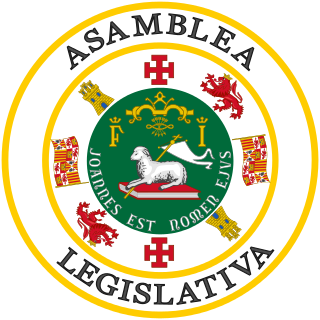
The Senate of Puerto Rico is the upper house of the Legislative Assembly of Puerto Rico, the territorial legislature of Puerto Rico. The Senate, together with the House of Representatives of Puerto Rico, control the legislative branch of the government of Puerto Rico.

The Legislative Assembly of Puerto Rico is the territorial legislature of the Commonwealth of Puerto Rico, responsible for the legislative branch of the government of Puerto Rico. The Assembly is a bicameral legislature consisting of an upper house, the Senate normally composed by 27 senators, and the lower house, the House of Representatives normally composed by 51 representatives. Eleven members of each house are elected at-large rather than from a specific legislative district with all members being elected for a four-year term without term limits.

The Jones–Shafroth Act —also known as the Jones Act of Puerto Rico, Jones Law of Puerto Rico, or as the Puerto Rican Federal Relations Act of 1917— was an Act of the United States Congress, signed by President Woodrow Wilson on March 2, 1917. The act superseded the Foraker Act and granted U.S. citizenship to anyone born in Puerto Rico on or after April 25, 1898. It also created the Senate of Puerto Rico, established a bill of rights, and authorized the election of a Resident Commissioner to a four-year term. The act also exempted Puerto Rican bonds from federal, state, and local taxes regardless of where the bond holder resides.
Liza Fernández Rodríguez is a Puerto Rican attorney and politician affiliated with the New Progressive Party (PNP). Fernández was a member of the House of Representatives of Puerto Rico from 2005 to 2012, and of the Senate of Puerto Rico from 2012 to 2013. In December 2012, after her electoral defeat, Fernández was confirmed as a Superior Judge.

Puerto Rico Senatorial District I, also known as the Senatorial District of San Juan, is one of the eight senatorial districts of Puerto Rico. It is currently represented by Miguel Romero and Henry Neumann.

Puerto Rico Senatorial District II, also known as the Senatorial District of Bayamón, is one of the eight senatorial districts of Puerto Rico. It is currently represented by Migdalia Padilla and Carmelo Ríos Santiago.

Puerto Rico Senatorial District III, also known as the Senatorial District of Arecibo, is one of the eight senatorial districts of Puerto Rico. It is currently represented by José Pérez Rosa and Angel Martínez.

Puerto Rico Senatorial District IV, also known as the Senatorial District of Mayagüez-Aguadilla, is one of the eight senatorial districts of Puerto Rico. It is currently represented by Evelyn Vázquez and Luis Daniel Muñiz.

Puerto Rico Senatorial District V, also known as the Senatorial District of Ponce, is one of the eight senatorial districts of Puerto Rico. It is currently represented by Ramón Ruiz and Martín Vargas Morales.

Puerto Rico Senatorial District VI, also known as the Senatorial District of Guayama, is one of the eight senatorial districts of Puerto Rico. It is currently represented by Miguel Pereira Castillo and Angel M. Rodríguez.

Puerto Rico Senatorial District VII, also known as the Senatorial District of Humacao, is one of the eight senatorial districts of Puerto Rico. It is currently represented by José Luis Dalmau and Miguel Laureano.

Puerto Rico Senatorial District VIII, also known as the Senatorial District of Carolina, is one of the eight senatorial districts of Puerto Rico. It is currently represented by Pedro A. Rodríguez and Luis Daniel Rivera.
The First Puerto Rican Senate was the first meeting of senators of the Senate of Puerto Rico elected as part of the legislative branch of their government. Elections for the Senate of Puerto Rico were authorized by passage of the Jones-Shafroth Act in 1917. It authorized elections to be held on July 6, 1917 for representative government in the legislature.
José Tous Soto was a Puerto Rican politician and former Senator and Representative.
Felix Antonio Santoni Rodriguez was a Puerto Rican politician and senator.
The Puerto Rico representative districts refers to the electoral districts in which Puerto Rico is divided for the purpose of electing 40 of the 51 members of the House of Representatives of Puerto Rico. The island is currently divided into 40 representative districts, each based on a similar number of inhabitants, and comprising one or more precincts—an electoral division divided, in turn, into colleges. A college usually is defined simply by the nearest public school to the voter's declared residence. American citizens may vote only for the district in which they have declared their residence, and only for up to one member of the House per district by first-past-the-post.

The 29th House of Representatives of Puerto Rico is the lower house of the 17th Legislative Assembly of Puerto Rico and will meet from January 14, 2013, to January 8, 2017. All members were elected in the General Elections of 2012. The House has a majority of members from the Popular Democratic Party (PPD).
Pedro Alfonzo Rodríguez González is a Puerto Rican politician from the Popular Democratic Party (PPD). Rodríguez was elected to the Senate of Puerto Rico in 2012. He also served as member of the House of Representatives of Puerto Rico in two separate instances, the last one to fill the vacancy left by Luis Farinacci.
Puerto Rico Representative district 29 is a representative district in Puerto Rico. Located in the center of the island, the district includes the cities of Cayey and Cidra.
Puerto Rico Representative district 10 is a representative district in Puerto Rico. Located in the northern coast of the island, the district is comprised only by the town of Toa Baja.














